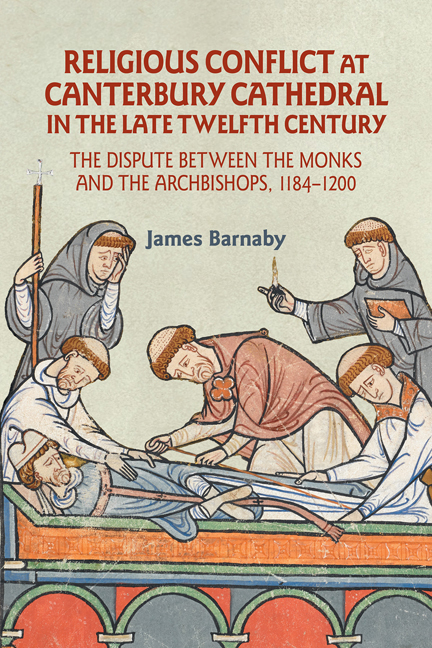 Religious Conflict at Canterbury Cathedral in the Late Twelfth Century
Religious Conflict at Canterbury Cathedral in the Late Twelfth Century Book contents
- Frontmatter
- Dedication
- Contents
- List of Maps
- Acknowledgements
- List of Abbreviations
- Introduction
- 1 The Canterbury Dispute in the Sources
- 2 Baldwin's Grand Plan (1184–November 1186)
- 3 To Rome (November 1186–July 1187)
- 4 The Hackington Dispute (August 1187–September 1189)
- 5 A New King, A Crusading Archbishop, and A Temporary Peace (September 1189–August 1191)
- 6 A New Primate (1191–3)
- 7 The Dispute Renewed (1193–1200)
- 8 After Lambeth: The Dispute in Later Centuries
- Conclusion
- Appendices
- Timeline
- Select Bibliography
- Index
- Other volumes in Studies in the History of Medieval Religion
4 - The Hackington Dispute (August 1187–September 1189)
Published online by Cambridge University Press: 09 May 2024
- Frontmatter
- Dedication
- Contents
- List of Maps
- Acknowledgements
- List of Abbreviations
- Introduction
- 1 The Canterbury Dispute in the Sources
- 2 Baldwin's Grand Plan (1184–November 1186)
- 3 To Rome (November 1186–July 1187)
- 4 The Hackington Dispute (August 1187–September 1189)
- 5 A New King, A Crusading Archbishop, and A Temporary Peace (September 1189–August 1191)
- 6 A New Primate (1191–3)
- 7 The Dispute Renewed (1193–1200)
- 8 After Lambeth: The Dispute in Later Centuries
- Conclusion
- Appendices
- Timeline
- Select Bibliography
- Index
- Other volumes in Studies in the History of Medieval Religion
Summary
The most dramatic period of the Canterbury dispute took place between 1187 and 1189. There was a significant heightening of animosities between Baldwin and the monks, with greater royal and papal involvement. It was during this period that the main legal battles at the curia took place, as well as open hostilities in England with Baldwin placing the cathedral under siege. It is also in this period that we are introduced to one of the most colourful of the participants in the conflict: the monk Roger Norreys. A supporter of the archbishop, Roger was so reviled by the convent that they imprisoned him for several months before he escaped, only to be imposed by Baldwin as the new prior. Gervase's description of Roger shows just how much he was hated. From youth he was:
haughty, pompous in speech, deceitful in deeds, covetous of authority, disdainful of religion, fawning towards superiors, contemptuous to inferiors, ostentatious in attire, negligent in the observation of the rule, a friend of women, a lover of horses, irritable when corrected, quick to slander, and incorrigible in everything.
Roger's involvement in the dispute reveals an important theme often overlooked in conflicts of this type. The monastery was not united in their opposition to the archiepiscopal plans, but rather a small group of monks (often holding important positions in the convent) was supportive of the archbishop. This, combined with greater royal and papal involvement in support of each side, led to a hardening of positions between the two parties, resulting in a turbulent time for the community at Canterbury.
Negotiating with King and Pope, August–December 1187
In early August 1187, Baldwin returned from his tour of Wales and once more seized the conventual estates in the face of the monks’ continued disobedience, and appealed to the pope against the mandates they had secured from the curia. The archbishop then summoned the cellarer and chamberlain to him, and ordered them to be responsible only to him instead of the conventual chapter as was the norm. This was the first step in Baldwin's plan to overhaul the management of the conventual estates. He proposed to divide the revenues into three: one part would go to the cellarer for the feeding of the monks; another would go to the chamberlain for their clothing, while a third part would be assigned to the sacrist for maintaining the church.
- Type
- Chapter
- Information
- Religious Conflict at Canterbury Cathedral in the Late Twelfth CenturyThe Dispute between the Monks and the Archbishops, 1184-1200, pp. 85 - 122Publisher: Boydell & BrewerPrint publication year: 2024
